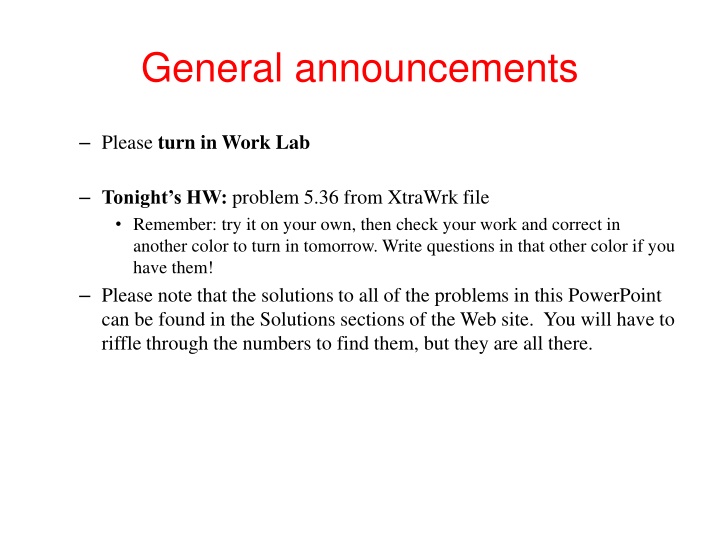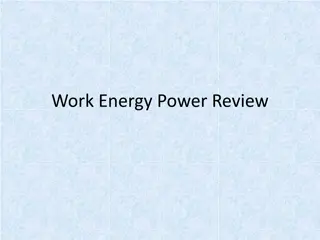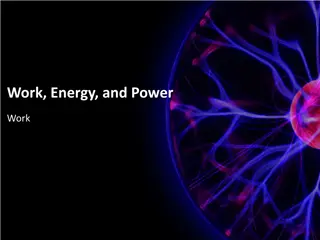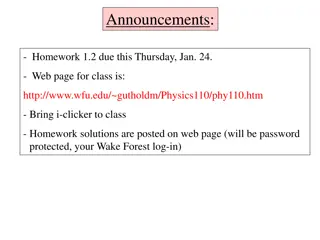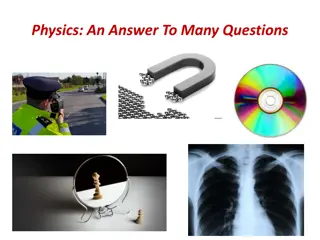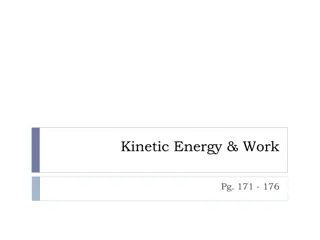Physics Homework Problems on Work and Energy Concepts
Solving physics homework problems related to work and energy, covering topics such as the Work-Energy Theorem, conservation of energy, forces, and displacement. Problems include calculating forces, speeds, tensions, and work done in various scenarios involving objects like pile drivers, toy guns, and pendulums.
Download Presentation

Please find below an Image/Link to download the presentation.
The content on the website is provided AS IS for your information and personal use only. It may not be sold, licensed, or shared on other websites without obtaining consent from the author.If you encounter any issues during the download, it is possible that the publisher has removed the file from their server.
You are allowed to download the files provided on this website for personal or commercial use, subject to the condition that they are used lawfully. All files are the property of their respective owners.
The content on the website is provided AS IS for your information and personal use only. It may not be sold, licensed, or shared on other websites without obtaining consent from the author.
E N D
Presentation Transcript
General announcements Please turn in Work Lab Tonight s HW: problem 5.36 from XtraWrk file Remember: try it on your own, then check your work and correct in another color to turn in tomorrow. Write questions in that other color if you have them! Please note that the solutions to all of the problems in this PowerPoint can be found in the Solutions sections of the Web site. You will have to riffle through the numbers to find them, but they are all there.
Things we know so far Work-Energy Theorem: ????= ?? Total (mechanical) energy is KE + U at any point KE = mv2 Gravity is a conservative force does not change total energy Its potential energy function is ??= ??? Does work ??= ( ??) Ideal springs also exert conservative forces Spring potential energy function is ???????=1 x is displacement from equilibrium position; k is spring constant Conservation of energy states: 2??2
Pile driver A 2100-kg pile driver is used to drive a steel I- beam into the ground. The pile driver falls 5.00 m from rest before coming into contact with the head of the beam, and it drives the beam 12.0 cm farther into the ground as it comes to rest. Using energy considerations, calculate the average force the beam exerts on the pile driver while the pile driver is brought to rest. 2100 kg 5.00 m 12 cm I-beam
Toy gun launch A 5.3 gram ball is projected by a spring in a gun. The spring s spring constant is 8.0 N/m. If the gun barrel is 15 cm and a constant frictional force of .032 N exists between the ball and the barrel, what is the ball s speed when it leaves the barrel. Assume the spring was compressed 5.0 cm for the launch?
Pendulum A block of mass m = 3 kg is attached to a rope of length L = 0.8 meters that is, itself, attached to the ceiling. The maximum tension the rope can handle without breaking is 33 N. Assuming the bob starts from rest, at what angle ? must the bob start if it is to break the rope as it goes through the bottom of the arc? q L
F-d graphs Given a graph of force vs displacement, how could you calculate the work done? On an Fd graph, the work done in any segment is the area under the graph. To get net work, add up each segment! What happens if the graph dips into F territory? (-work is done)
Fd graph Given the force vs displacement graph below, determine: (a) the work done for each segment of the graph (AB, BC, CD, DE) (b) the net work done (c) if the object has a mass of 1 kg and v = 1 m/s at x = 0, how fast is it moving at point C? F (N) 6 A B 4 2 x (m) 5 10 15 20 25 -2 -4 C D -6
Roller coaster An 850-kg roller coaster is released from rest at point A of the track as shown below, 140 m above the ground. Assume there are no resistive forces between points A and C on the track. (a) How fast is the roller coaster moving at point B? (b) How fast is the roller coaster moving at point C? (c) What average force is required to bring the roller coaster to a stop at point D if the brakes are applied at point C?
